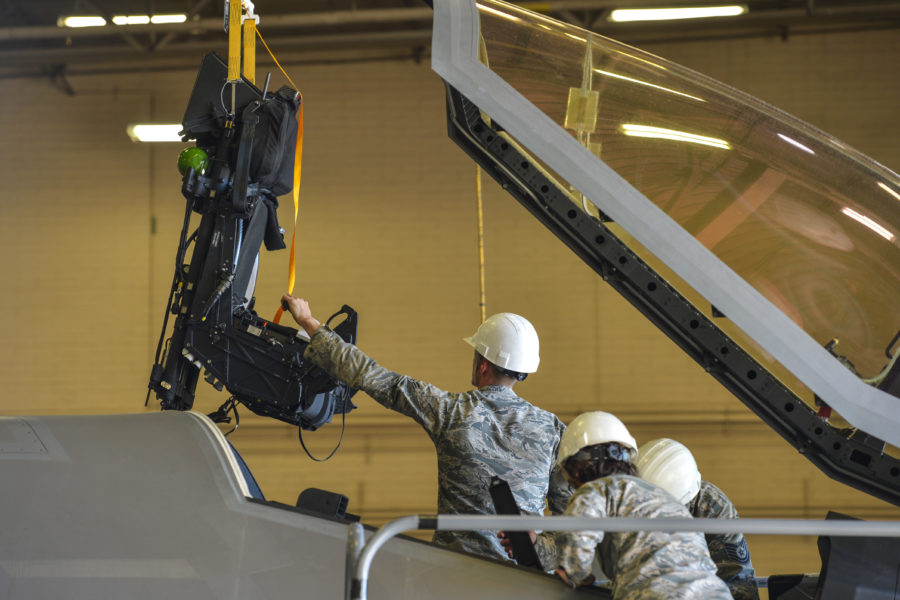The U.S. fleet of F-35 fighters continued to be vexed by reliability, maintainability, and availability (RMA) problems last fiscal year, available for operations only 51 percent of the time—compared to a goal of 65 percent—according to the Director of Operational Test and Evaluation’s annual report.
“The operational suitability of the F-35 fleet remains below service expectations and requirements,” according to the report, published in late January.
Aircraft availability among all U.S. F-35s hit its high water mark in January 2021 but has declined since, the report authors noted.
“In [fiscal year 2023], aircraft availability was slightly below that in FY’22, after declining for most of FY’21,” the report assessed. “Available” means an F-35 can do at least one of its many assigned missions.
The RMA performance of the F-35 has been the subject of numerous congressional hearings and Government Accountability Office reports over the years, and the Pentagon has launched many initiatives meant to get mission capability rates up.
Newer aircraft—with more proven components—have tended to perform better than older ones across the 20-year-old program, and the Pentagon has argued that the complexity of the stealthy and computer-intensive jet means its availability shouldn’t be judged against less-complex earlier types of aircraft.
Even though the F-35 still has not met the developmental exit criteria to enter “full rate production,” the flying hours accumulated by the fleet mean it should be viewed as a largely mature system.
A total of 628 F-35s had been delivered to the Air Force, Marine Corps, and Navy by the end of September 2023, but that figure doesn’t include aircraft in developmental test or any of the F-35s completed but now in storage, awaiting completion of Tech Refresh-3 update testing. The report did not assess F-35 performance with foreign operators.
Aircraft that were combat-coded—which typically receive priority for spare parts and maintenance—achieved the best performance for availability, the report stated, noting that 61 percent were available on an average monthly basis. But that was still below the goal of 65 percent, and in only one month of fiscal 2023 did the F-35 fleet surpass the goal. Across all F-35s, the average was 51 percent.
Viewed in terms of full mission capability—which means an F-35 is “capable of executing all assigned missions”—combat-coded aircraft again did better than the overall fleet but fell well short of the goal. Across 2023, the combat-coded fleet achieved a monthly full mission capable rate average of 48 percent, versus 30 percent for the whole fleet. The full mission capable rate for the operational test fleet was only nine percent. Non-combat-coded aircraft include those down for maintenance, in depot, or being used as daily trainers.
Slightly more than half the fleet—51 percent, as of the end of September 2023—is now combat-coded, the report noted.
Aircraft dubbed “not available” are designated as such when they are in depot or unable to fly due to maintenance or supply issues. Rates of aircraft down due to supply was 27 percent; “relatively flat” but “slightly worse” than the fiscal 2023 rate, the report noted. It’s been on a worsening trend since July 2021.
Aircraft down because they were awaiting maintenance in 2023 was 15 percent.
“To improve aircraft availability, the program should continue to pursue maintenance system improvements, especially for common processes distributed among many different [Non-Mission Capable for Maintenance] drivers, such as low-observable repairs, adhesive cure times for attaching hardware such as nutplates,” and stocking enough of the “most critical” in-demand spares, the DOT&E report stated.
“The program should also focus reliability improvements on the components most often not immediately available in supply,” the report added.
Particularly for the Air Force F-35A version, “the significant shortage of fully-functional F135 engines contributed” to lower aircraft availability.
This was offset in part by “aggressive program efforts to lay in additional depot resources, improve depot efficiencies, and ruggedize key engine components,” and increasing “the number of spare modules ready for issue,” the report noted.
However, “other degraders such as canopy and egress system issues have contributed to stagnant, or slightly declining, availability.”
As a fleet, the F-35 still isn’t meeting the reliability and maintainability standards set in the Operational Requirements Document, the report noted.
“The F-35A meets two and the F-35B meets one of the three reliability requirements. No variant is meeting [all] the maintainability requirements,” it said.
The F-35A fleet was supposed to achieve a rate of 20 Mean Flight Hours Between Critical Failures after 75,000 fleet hours. But in 2023, it only achieved a rate of 10.5, despite having racked up more than 288,000 total flight hours since entering service. The F-35B variant, operated by the Marines, and the F-35C, flown by the Navy, both missed their goals as well.
The main drivers of critical failures were “troubleshooting (including software stability), attaching hardware (including nutplates), wires/tubes/ducts/ fiber optics, throttle grip, aircraft memory device, [low observability] repair, standby flight display, refueling door, position light,” the report noted.
The fix times for “critical failures” was double the operational requirement for the Air Force, nearly three times for the Marine Corps, and more than double for the Navy.
In the category of Mean Flight Hours Between Removal, all the variants did better, achieving 108 percent for the A model and 78 percent each for the B and C.
All the variants came close to or beat the requirement for “Mean Flight Hours Between Maintenance Events (Unscheduled),” with the Air Force and Navy F-35s besting the requirement by 110 percent and 120 percent, respectively, while the Marine Corps hit 80 percent of the goal.
DOT&E’s recommendations regarding RMA mirrored those of the fiscal 2022 report. It urged continued maintenance system improvements and more investment in spares, “especially for F135 engines, to reduce down-time for aircraft waiting [for] spare parts by developing alternate sources of repair, including organic repair.”
